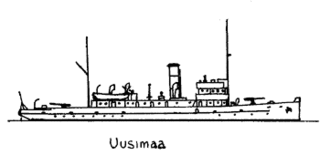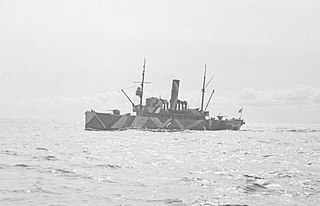
The Finnish Navy is one of the branches of the Finnish Defence Forces. The navy employs 2,300 people and about 4,300 conscripts are trained each year. Finnish Navy vessels are given the ship prefix "FNS", short for "Finnish Navy ship", but this is not used in Finnish language contexts. The Finnish Navy also includes coastal forces and coastal artillery.
Vesikko is a submarine, which was launched on 10 May 1933 at the Crichton-Vulcan dock in Turku. Until 1936 it was named by its yard number CV 707. Vesikko was ordered by a Dutch engineering company Ingenieurskantoor voor Scheepsbouw in 1930 as a commercial submarine prototype, being the prototype for the German Type II submarines. Purchased by the Finnish before World War II, she saw service in the Winter War and Continuation War, sinking the Soviet merchant ship Vyborg as her only victory. After the cease-fire with the Allies in 1944, Vesikko was retired. Finland was banned from operating submarines after the war and she was kept in storage until she was turned into a museum ship.

The Baltic Sea Campaigns were conducted by Axis and Allied naval forces in the Baltic Sea, its coastal regions, and the Gulf of Finland on the Eastern Front of World War II. After early fighting between Polish and German forces, the main combatants were the Kriegsmarine and the Soviet Navy, with Finland supporting the Germans until 1944 and the Soviets thereafter. The Swedish Navy and merchant fleet played important roles, and the British Royal Navy planned Operation Catherine for control of the Baltic Sea and its exit choke point into the North Sea.

Vesihiisi was a Finnish 500-tonne Vetehinen-class submarine that was constructed in the early 1930s. The vessel served in the Finnish Navy during the second World War.

Vetehinen was a 500-tonne Vetehinen-class submarine that was constructed in the early 1930s, which served in the Finnish Navy during the Second World War. The submarine was the first ship of its class of three submarines. The name vetehinen means "merman".

Iku-Turso was a 500-tonne Vetehinen-class submarine that served in the Finnish Navy during the Second World War. It was launched in May 1931 and was named after a mythological Finnish sea monster, Iku-Turso. It was built by the Crichton-Vulcan shipyard in Turku according to a project developed by NV Ingenieurskantoor voor Scheepsbouw, "IvS", and was scrapped in 1953.

Saukko (Pu110) was a small submarine that served in the Finnish Navy during the Second World War. It was designed not to exceed 100 tonnes, as it was planned for use in Lake Ladoga, and according to the 1920 Treaty of Tartu, no nation was allowed to use naval ships of more than 100 tonnes on the lake. The submarine could be divided into separate sections and transported by rail. The conning tower could be lifted off entirely. The engines were in the aft section and the batteries in the forward section. The name "Saukko" means European otter.

Karjala (ex-Filin) was a Finnish gunboat, built in 1918 at Ab Crichton shipyard in Turku. She served in the Finnish Navy during World War II. Karjala was named after the Finnic cultural region of Karelia. Like her sister ship Turunmaa, she served as cadet training vessel during peacetime and was nicknamed as Kurjala by cadets.

Uusimaa was a gunboat that served in the Finnish Navy during World War II. She was built in 1917. As the ship had changed hands many times during the turbulent last years of World War I she had been renamed many times: In Russian service, she was called Golub, later, in German service, her name was Beo. Finally the Germans handed her over to the Finns in 1920, who renamed her Uusimaa. After World War II, she served as a trawler in the Baltic Sea. She was scrapped in 1953.

Hämeenmaa was a gunboat that served in the Finnish Navy during World War II. She was built in 1917. As the ship had changed hands many times during the turbulent last years of World War I she had been renamed many times: In Russian service, she was called Pingvin; later, in German service, her name was Wulf. Finally, in 1920, the Germans handed her over to the Finns, who renamed her Hämeenmaa. After World War II, she served as a trawler in the Baltic Sea. She was scrapped in 1953.
The Sisu-class motor torpedo boats was a series of two Italian MAS type motor torpedo boats of the Finnish Navy. The vessels were constructed in 1916 by the Orlando shipyard in Livorno, Italy. Sisu and Hurja were purchased by the Finns in 1920, and saw service in World War II. When dashing forward at full speed, the vessels sprayed water high in the air, earning the nickname "the fountains" from Finnish sailors.
The Syöksy-class motor torpedo boats was a series of four British Thornycroft type motor torpedo boats of the Finnish Navy. The vessels were constructed in 1928 by the John Thornycroft & Co. shipyard in Woolton, UK. The vessels saw service in World War II. The Thornycroft type released its torpedoes by dropping them from rails in the aft. The ship then had to steer away from the torpedoes path, a manoeuvre that could be quite tricky in the close waters of the Gulf of Finland.
Finnish Ladoga Naval Detachment was a Finnish naval unit stationed on Lake Ladoga between 1920–1940 and 1941–1944.

The Battle of Someri was a battle in the Gulf of Finland during World War II on 8–9 July 1942, between the Soviet Union and Finland. Starting as a modest operation to clear a Finnish observation post from a small island, it became one of the largest surface ship engagements in the Baltic theater.

Ruotsinsalmi was a minelayer of the Finnish Navy and the namesake of her class. Ruotsinsalmi was commissioned in 1940 and remained in service until 1975. The vessel was named after the battle of Ruotsinsalmi, which was fought between Sweden and Russia in 1790.

An udema, also udenma, was a type of warship built for the Swedish archipelago fleet in the late 18th and early 19th centuries. It was developed for warfare in the Archipelago Sea in the Baltic and along the coasts of Svealand and Finland against the Russian navy. The udema was designed by the prolific naval architect Fredrik Henrik af Chapman for use in an area of mostly shallow waters and groups of islands and islets that extend from Stockholm all the way to the Gulf of Finland.

Filin-class guard ships were a class of ships originally built in Finland as patrol vessels for the Imperial Russian Navy. With the withdrawal of Russia from the area, the ships went to other use.

Golub-class guard ships were originally built as minelayers and netlayers for the Imperial Russian Navy. Two of the ships were captured by the Germans at Tallinn in 1918 and were given to Finland in 1920. Four more were completed in 1919 and sold via Germans to Chilean Navy.

Louhi was a Finnish Navy minelayer. The ship was originally constructed for the Imperial Russian Navy but was taken over by the Finns during the Russian Civil War. She had originally been named Voin, but was renamed as M1 in Finnish service. In 1936 she was given the more personal name Louhi, following the procedure of all other major ships in the Finnish navy.
The Teplokhod class motor minelayer was constructed as inshore motor minelayers intended for laying ground controlled shallow water minefields. Their small size and ability to maneuver in shallow waters made them suited for this task however those same features made it dangerous to operate these ships in open sea.














